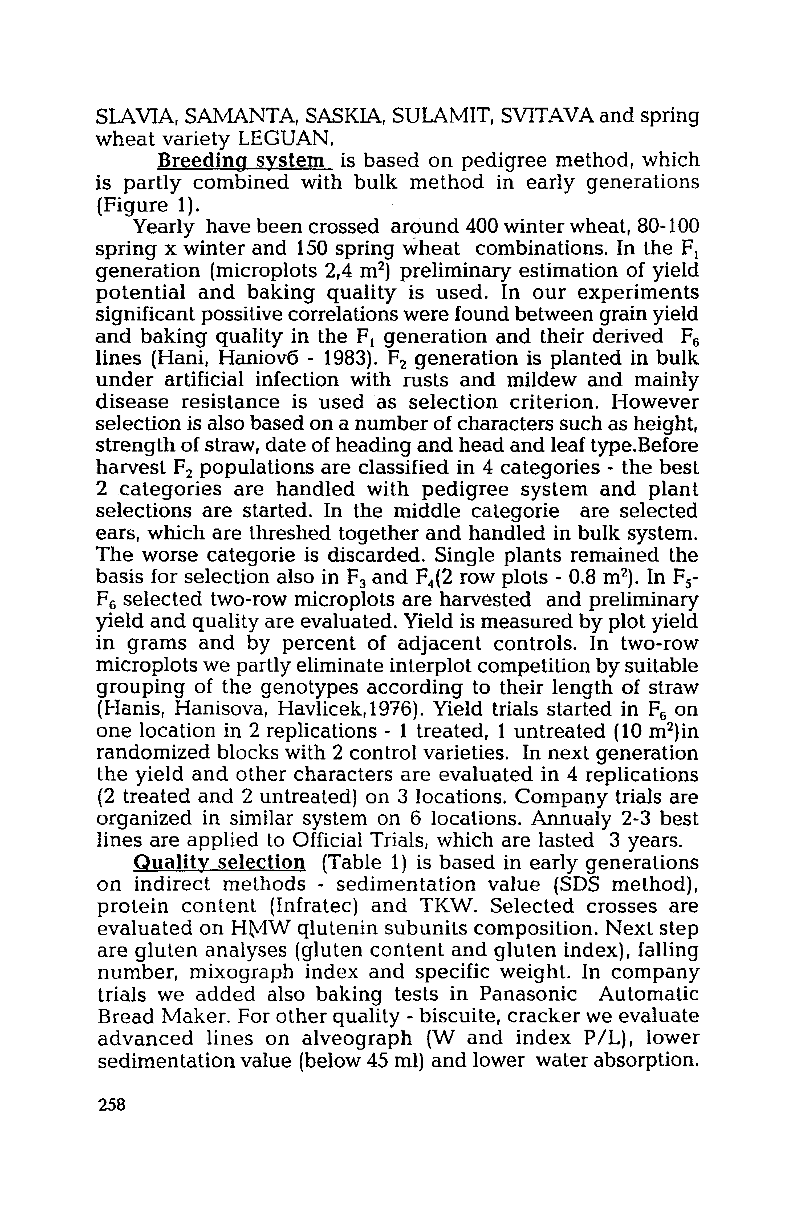

SLAVIA, SAMANTA, SASKIA, SULAMIT, SVITAVA and spring
wheat variety LEGUAN.
Breeding system is based on pedigree method, which
is partly combined with bulk method in early generations
(Figure 1).
Yearly have been crossed around 400 winter wheat, 80-100
spring x winter and 150 spring wheat combinations. In the Fj
generation (microplots 2,4 m2) preliminary estimation of yield
potential and baking quality is used. In our experiments
significant possitive correlations were found between grain yield
and baking quality in the
generation and their derived F
6
lines (Hani, Haniovb - 1983). F
2
generation is planted in bulk
under artificial infection with rusts and mildew and mainly
disease resistance is used as selection criterion. However
selection is also based on a number of characters such as height,
strength of straw, date of heading and head and leaf type.Before
harvest F
2
populations are classified in 4 categories - the best
2
categories are handled with pedigree system and plant
selections are started. In the middle categorie are selected
ears, which are threshed together and handled in bulk system.
The worse categorie is discarded. Single plants remained the
basis for selection also in F
3
and F4(2 row plots - 0.8 m2). In F5-
F
6
selected two-row microplots are harvested and preliminary
yield and quality are evaluated. Yield is measured by plot yield
in grams and by percent of adjacent controls. In two-row
microplots we partly eliminate interplot competition by suitable
grouping of the genotypes according to their length of straw
(Hanis, Hanisova, Havlicek,1976). Yield trials started in F
6
on
one location in
2
replications -
1
treated,
1
untreated
(10
m2)in
randomized blocks with 2 control varieties. In next generation
the yield and other characters are evaluated in 4 replications
(2 treated and 2 untreated) on 3 locations. Company trials are
organized in similar system on
6
locations. Annualy 2-3 best
lines are applied to Official Trials, which are lasted 3 years.
Quality selection (Table 1) is based in early generations
on indirect methods - sedimentation value (SDS method),
protein content (Infratec) and TKW. Selected crosses are
evaluated on HMW qlutenin subunits composition. Next step
are gluten analyses (gluten content and gluten index), falling
number, mixograph index and specific weight. In company
trials we added also baking tests in Panasonic Automatic
Bread Maker. For other quality - biscuite, cracker we evaluate
advanced lines on alveograph (W and index P/L), lower
sedimentation value (below 45 ml) and lower water absorption.
258
Научная электронная библиотека ЦНСХБ









